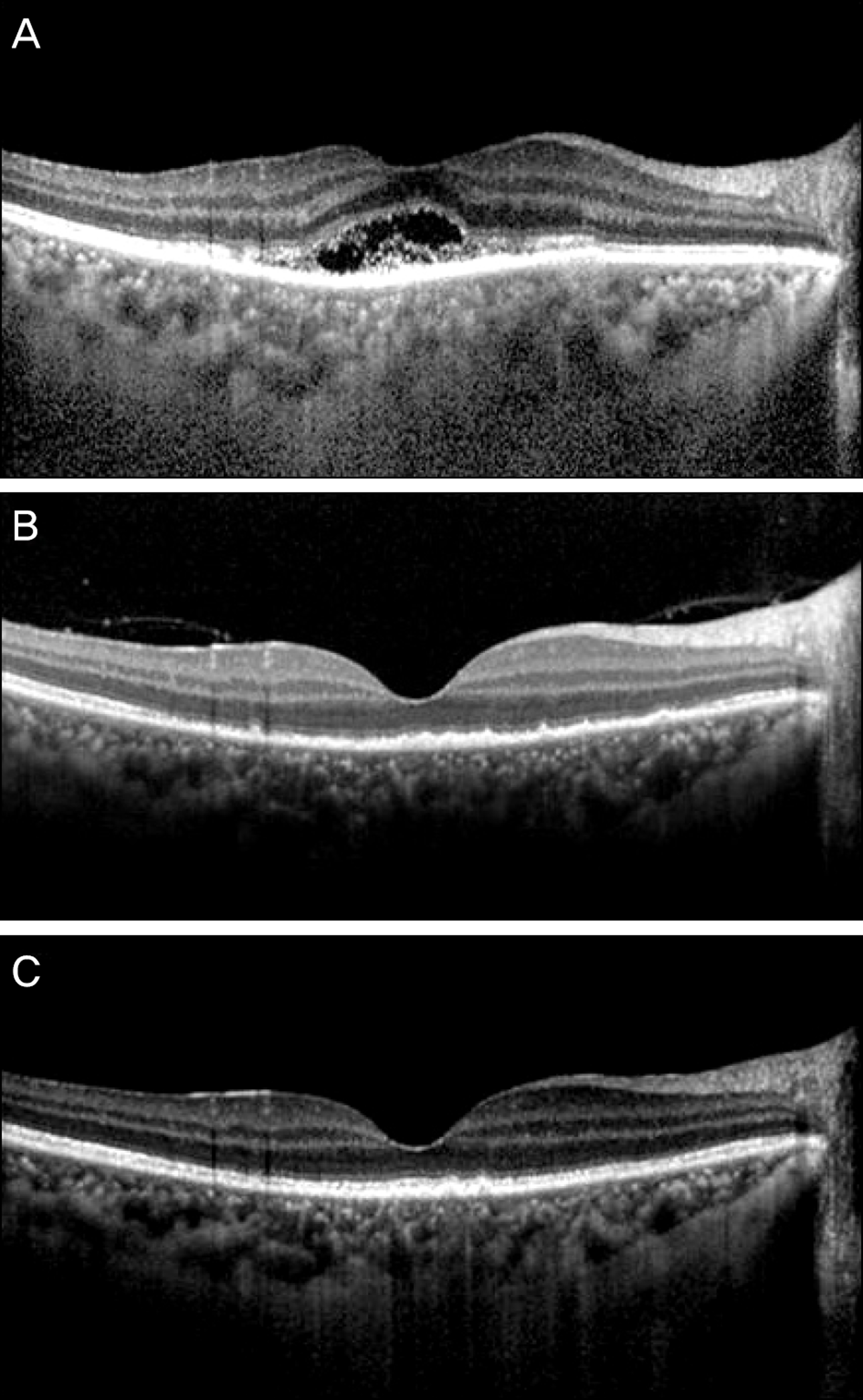J Korean Ophthalmol Soc.
2013 May;54(5):829-833. 10.3341/jkos.2013.54.5.829.
Clinical Course Following Intravitreal Bevacizumab Injection in Posterior Placoid Chorioretinitis
- Affiliations
-
- 1Department of Ophthalmology, Hallym University Chuncheon Sacred Heart Hospital, Hallym University College of Medicine, Chuncheon, Korea. jiwoneye@hallym.or.kr
- 2Department of Ophthalmology, Seoul Metropolitan Dongbu Hospital, Seoul, Korea.
- KMID: 2217055
- DOI: http://doi.org/10.3341/jkos.2013.54.5.829
Abstract
- PURPOSE
To report the clinical course with optical coherence tomography findings following intravitreal bevacizumab injection in patients with posterior placoid chorioretinitis due to latent syphilis.
CASE SUMMARY
A 43-year-old woman presented with visual dimness in the right eye 3 days in duration. Fundus examination showed yellow, placoid lesions in the right eye and there was no cell reaction in the anterior chamber and vitreous. An intravitreal bevacizumab injection was given and systemic work-up performed. After 1 week, the macular lesion disappeared. However, photoreceptor disarrangement was present on spectral-domain optical coherence tomography image. On serologic test, the Venereal Disease Research Laboratory test, and fluorescent treponemal antigen absorption test were positive. She was referred to a division of infectious diseases and confirmed as latent syphilis. The patient received intramuscular penicillin 3 times weekly. Visual acuity and outer retinal abnormality further improved and there was no recurrence during the 6-month follow-up.
CONCLUSIONS
Intravitreal bevacizumab injection added to antibiotic treatment may be considered for treating patients with posterior placoid chorioretinitis. Further studies are necessary to evaluate precise disease mechanisms and treatment.
Keyword
MeSH Terms
-
Absorption
Anterior Chamber
Antibodies, Monoclonal, Humanized
Chorioretinitis
Communicable Diseases
Eye
Female
Humans
Penicillins
Recurrence
Retinaldehyde
Serologic Tests
Sexually Transmitted Diseases
Syphilis
Syphilis, Latent
Tomography, Optical Coherence
Visual Acuity
Bevacizumab
Antibodies, Monoclonal, Humanized
Penicillins
Retinaldehyde
Figure
Reference
-
References
1. Aldave AJ, King JA, Cunningham ET Jr. Ocular syphilis. Curr Opin Ophthalmol. 2001; 12:433–41.
Article2. Kiss S, Damico FM, Young LH. Ocular manifestations and treat-ment of syphilis. Semin Ophthalmol. 2005; 20:161–7.
Article3. Gass JD, Braunstein RA, Chenoweth RG. Acute syphilitic posteri-or placoid chorioretinitis. Ophthalmology. 1990; 97:1288–97.
Article4. Tamesis RR, Foster CS. Ocular syphilis. Ophthalmology. 1990; 97:1281–7.
Article5. Villanueva AV, Sahouri MJ, Ormerod LD, et al. Posterior uveitis in patients with positive serology for syphilis. Clin Infect Dis. 2000; 30:479–85.
Article6. Barile GR, Flynn TE. Syphilis exposure in patients with uveitis. Ophthalmology. 1997; 104:1605–9.
Article7. Durnian JM, Naylor G, Saeed AM. Ocular syphilis: the return of an old acquaintance. Eye (Lond). 2004; 18:440–2.
Article8. Zamani M, Garfinkel RA. Corticosteroid-induced modulation of acute syphilitic posterior placoid chorioretinitis. Am J Ophthalmol. 2003; 135:891–4.
Article9. Tran TH, Cassoux N, Bodaghi B, et al. Syphilitic uveitis in patients infected with human immunodeficiency virus. Graefes Arch Clin Exp Ophthalmol. 2005; 243:863–9.
Article10. Erol N, Topbas S. Acute syphilitic posterior placoid chorioretinitis after an intravitreal triamcinolone acetonide injection. Acta Ophthalmol Scand. 2006; 84:435.
Article11. Yoo C, Kim SK, Huh K, Oh J. Atypical acute syphilitic posterior placoid chorioretinitis. Korean J Ophthalmol. 2009; 23:108–11.
Article12. Brito P, Penas S, Carneiro A, et al. Spectral-domain optical coher-ence tomography features of acute syphilitic posterior placoid cho-rioretinitis: the role of autoimmune response in pathogenesis. Case Report Ophthalmol. 2011; 25:39–44.
Article13. Joseph A, Rogers S, Browning A, et al. Syphilitic acute posterior placoid chorioretinitis in nonimmuno-compromised patients. Eye (Lond). 2007; 21:1114–9.
Article14. Chen J, Lee L. Posterior placoid chorioretinitis: An unusual ocular manifestation of syphilis. Clin Ophthalmol. 2008; 2:669–73.
Article15. Baglivo E, Kapetanios A, Safran AB. Fluorescein and indocyanine green angiographic features in acute syphilitic macular placoid chorioretinitis. Can J Ophthalmol. 2003; 38:401–5.
Article16. Meira-Freitas D, Farah ME, Höfling-Lima AL, Aggio FB. Optical coherence tomography and indocyanine green angiography find-ings in acute syphilitic posterior placoid choroidopathy: case report. Arq Bras Oftalmol. 2009; 72:832–5.
Article17. Campochiaro PA. Targeted pharmacotherapy of retinal diseases with ranibizumab. Drugs Today (Barc). 2007; 43:529–37.
Article18. Cordero Coma M, Sobrin L, Onal S, et al. Intravitreal bevacizumab for treatment of uveitic macular edema. Ophthalmology. 2007; 114:1574–9.
Article19. Ossewaarde-van Norel A, Rothova A. Clinical review: Update on treatment of inflammatory macular edema. Ocul Immunol Inflamm. 2011; 19:75–83.
Article20. Gulati N, Forooghian F, Lieberman R, Jabs DA. Vascular endothe-lial growth factor inhibition in uveitis: a systematic review. Br J Ophthalmol. 2011; 95:162–5.
Article21. Modorati G, Miserocchi E. Intravitreal injection therapy in the treatment of noninfectious uveitis. Dev Ophthalmol. 2012; 51:110–21.
Article
- Full Text Links
- Actions
-
Cited
- CITED
-
- Close
- Share
- Similar articles
-
- Intravitreal Bevacizumab Injection for the Treatment of Choroidal Neovascularization Secondary to Candida Chorioretinitis
- Relentless Placoid Chorioretinitis in a Young Man
- Atypical Acute Syphilitic Posterior Placoid Chorioretinitis
- Intravitreal Bevacizumab (Avastin) as an Adjuvant for the Treatment of Posterior Scleritis
- Optical Coherence Tomography Angiography in Refractory Diabetic Macular Edema



